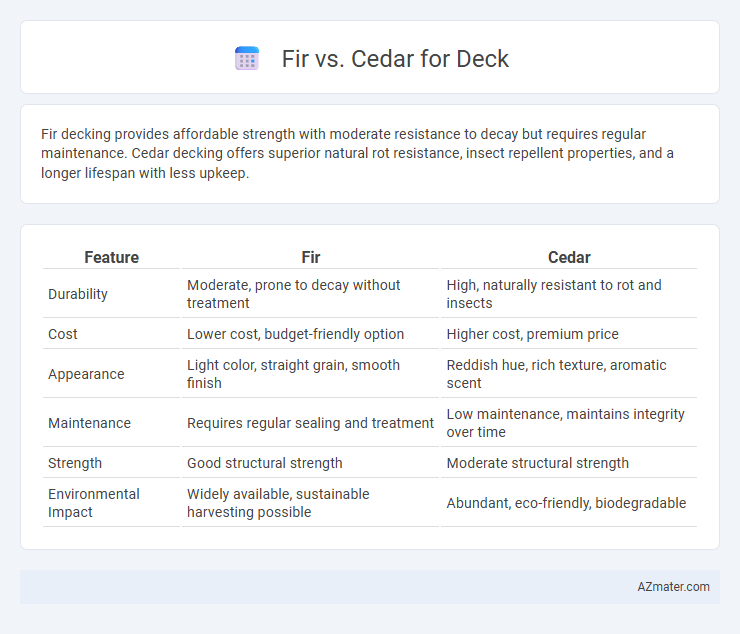Fir decking provides affordable strength with moderate resistance to decay but requires regular maintenance. Cedar decking offers superior natural rot resistance, insect repellent properties, and a longer lifespan with less upkeep.
Table of Comparison
| Feature | Fir | Cedar |
|---|---|---|
| Durability | Moderate, prone to decay without treatment | High, naturally resistant to rot and insects |
| Cost | Lower cost, budget-friendly option | Higher cost, premium price |
| Appearance | Light color, straight grain, smooth finish | Reddish hue, rich texture, aromatic scent |
| Maintenance | Requires regular sealing and treatment | Low maintenance, maintains integrity over time |
| Strength | Good structural strength | Moderate structural strength |
| Environmental Impact | Widely available, sustainable harvesting possible | Abundant, eco-friendly, biodegradable |
Introduction to Fir and Cedar Decking
Fir decking offers a durable and affordable option known for its strength and resistance to decay, making it suitable for outdoor use. Cedar decking is prized for its natural resistance to moisture and insects, along with its rich aroma and beautiful grain that enhances any outdoor space. Both fir and cedar provide excellent choices, with fir excelling in structural applications and cedar favored for aesthetic appeal and longevity.
Comparing Fir vs Cedar: Key Differences
Fir offers a strong, straight-grained option with a lighter color that is typically more affordable and readily available compared to cedar. Cedar naturally resists decay and insect damage due to its high concentration of extractives, making it ideal for outdoor decks, while fir requires treatment for enhanced durability. Over time, cedar weathers to a silver-gray patina without warping, whereas fir is prone to checking and may need regular maintenance to preserve its appearance and strength.
Durability and Lifespan of Fir and Cedar Decks
Fir decks offer moderate durability with a lifespan of approximately 10 to 15 years, requiring regular maintenance to resist rot and insect damage. Cedar decks outperform fir in natural resistance to decay and insects, often lasting 15 to 30 years with proper care due to its inherent oils and dense grain. Choosing cedar enhances longevity and reduces upkeep frequency compared to fir, making it a preferred option for durable decking.
Appearance and Aesthetic Appeal
Fir wood offers a smooth, uniform grain with a pale, reddish-brown hue that develops a warm, golden patina over time, making it a popular choice for modern, minimalist decks. Cedar presents a rich, reddish color with distinct grain patterns and natural knots, providing a rustic and inviting aesthetic that enhances outdoor spaces with its classic charm. Both woods age gracefully, but cedar's natural oils resist weathering, maintaining its vibrant appearance longer without extensive maintenance.
Weather Resistance and Rot Protection
Fir offers moderate weather resistance and requires regular sealing to prevent moisture damage, making it less ideal for prolonged exposure to harsh elements. Cedar naturally contains oils and tannins that provide superior rot protection and repel insects, ensuring longer-lasting durability in outdoor deck applications. Choosing cedar over fir significantly reduces maintenance needs and enhances the deck's lifespan in wet or variable climates.
Maintenance Requirements: Fir vs Cedar
Fir decks require more frequent sealing and staining due to their softer wood composition, making maintenance necessary every 1-2 years to prevent rot and decay. Cedar naturally contains oils and tannins that resist insects and moisture, reducing the need for regular treatments and extending maintenance intervals to 3-5 years. Proper maintenance for fir involves thorough cleaning and protective coatings, while cedar benefits from occasional cleaning and occasional application of sealant to maintain its durability and appearance.
Cost Comparison: Fir Decking vs Cedar Decking
Fir decking typically costs less than cedar, with average prices ranging from $2 to $4 per square foot, making it a budget-friendly option for deck construction. Cedar decking, priced between $3 and $6 per square foot, offers enhanced durability and natural resistance to rot and insects, which can lower long-term maintenance costs. When comparing fir vs cedar for decks, initial cost savings with fir must be balanced against cedar's superior longevity and reduced treatment expenses.
Environmental Impact and Sustainability
Fir decks offer a moderate environmental footprint due to their fast growth rates and widespread availability in managed forests, supporting sustainable harvesting practices. Cedar is highly sustainable, with natural resistance to rot and insects reducing the need for chemical treatments, and it often comes from certified forests committed to ecological balance. Both woods contribute to carbon sequestration during their growth, but cedar's longer lifespan and durability typically enhance its overall sustainability profile in decking applications.
Best Applications for Fir and Cedar Decks
Fir wood offers strong structural integrity and is ideal for load-bearing deck components such as joists, beams, and posts due to its high strength-to-weight ratio. Cedar excels in decking boards and railings where natural resistance to decay, insects, and moisture is crucial, providing long-lasting durability and minimal maintenance. Both woods perform well outdoors, but fir requires treatment to resist rot, while cedar's natural oils make it an optimal choice for exposed surfaces.
Conclusion: Choosing the Right Wood for Your Deck
Fir offers affordability and strength with a smooth finish but requires regular maintenance due to its moderate durability. Cedar provides natural resistance to rot, insects, and weather, making it ideal for long-lasting, low-maintenance decks despite a higher initial cost. Selecting between fir and cedar depends on balancing budget, desired lifespan, and maintenance commitment for your outdoor space.

Infographic: Fir vs Cedar for Deck
 azmater.com
azmater.com